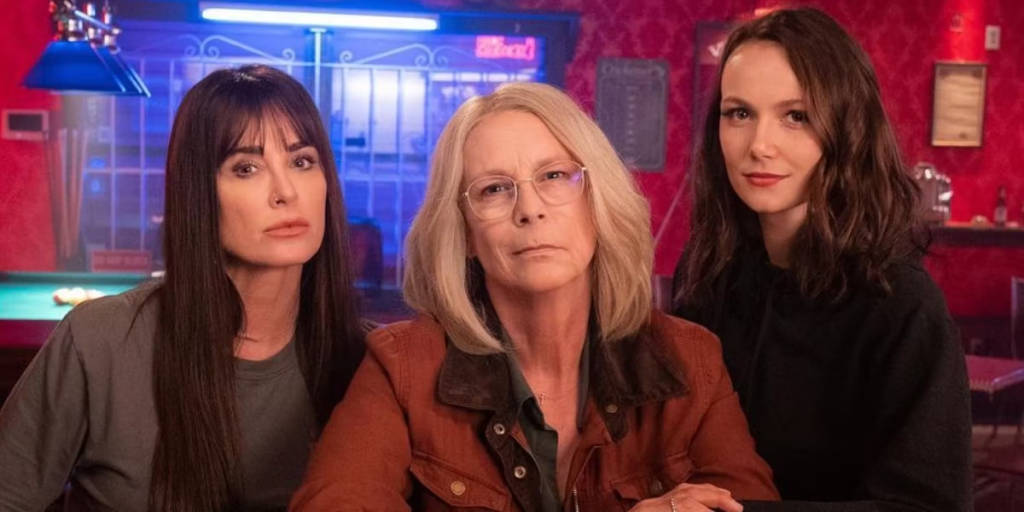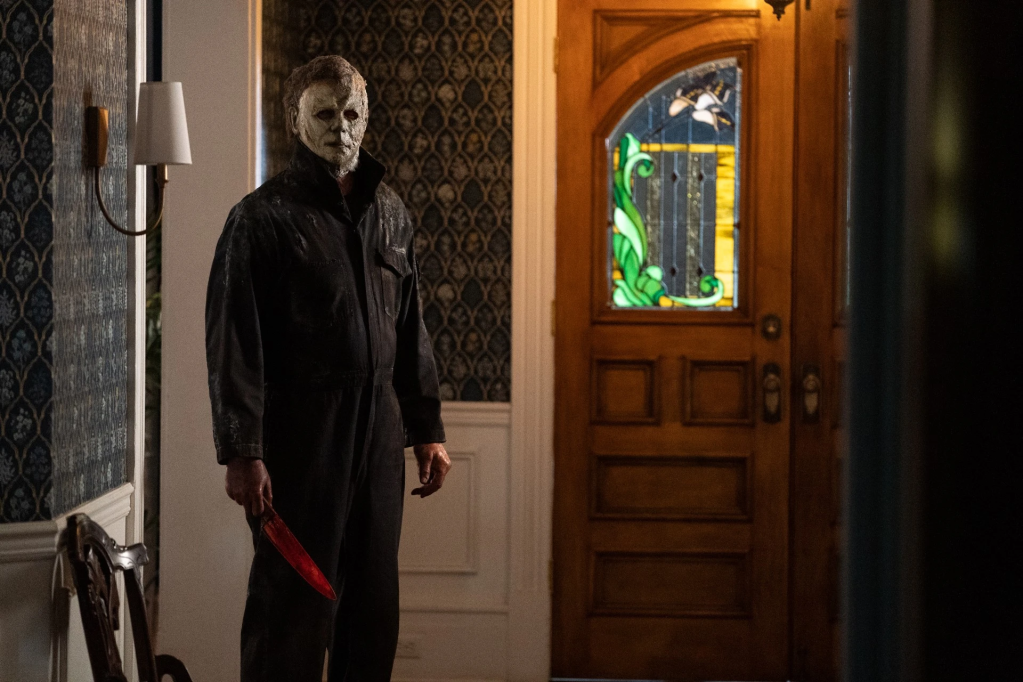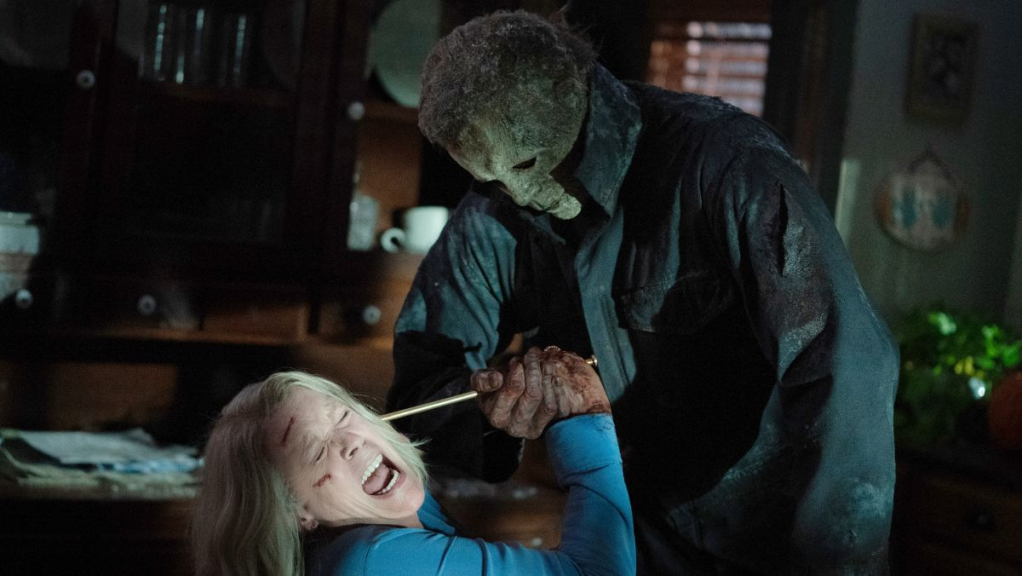Since its release, John Carpenter’s Halloween has been the gold standard by which all other slashers are judged. Despite decades of attempts, very few slashers have matched the craftsmanship or reputation of the original classic, and few have suffered as much unfavorable comparisons as Halloween’s own sequels. Perhaps that’s why, to close out his new trilogy of Halloween films, director David Gordon Green asked why bother trying, and created one of the most unique sequels in recent memory.
Halloween Ends picks up four years after the events of the 2018 Halloween and its sequel, Halloween Kills. Laurie Strode (Jamie Lee Curtis) is now living with her granddaughter Allyson (Andi Matichak) and the two are trying to put their lives back together after Michael Myers (James Jude Courtney) murdered Laurie’s daughter (Judy Greer) and vanished without a trace. Both Laurie and Allyson are outcasts in the community, with Laurie being blamed for the events of 2018. Their lives take an unusual turn when Laurie befriends Corey Cunningham (Rohan Campbell) a similar outcast who has been maligned by the community following a tragic accident for which he is blamed. Things seem to be going well at first, until Corey has a chance encounter with Myers, who is now living in seclusion in a shut-down portion of the city’s sewer system. Following this, Laurie grows suspicious of Corey when she notices his behavior is starting to resemble that of her nemesis. Allyson falls deeper and deeper in love with Corey, unaware that Corey is growing more and more obsessed with her mother’s killer.
Green cites John Carpenter’s Christine as a major inspiration. Christine told the story of young social outcast Arnie Cunningham as he is seduced and corrupted by a malevolent 50s Plymouth Fury. It wasn’t a slasher film, and neither is Halloween Ends. What Ends does is take the titular car from that film and replace it with the mysterious Shape. While there are some elements of the slasher genre in Halloween Ends, it’s important to realize that on the whole, the film tries to be different than the original and its previous follow-ups. Instead, Halloween Ends takes the unique approach to show the audience the aftermath of a slasher film, the effects it has on survivors, the town, the killer, and the effects they all have on each other.

At its core, the film is about Laurie Strode and Michael Myers, with Allyson and Corey forming a bridge between them. Jamie Lee Curtis delivers perhaps her best performance since the original. No longer the gruff survivalist from 2018, Strode is attempting to mend her relationship with her granddaughter, with the two both living and grieving together. In Curtis, you see reflections of the shy and awkward girl she played in the original, such as during a chance encounter with Hawkins (Will Patton) at the market. But there is still a really wounded person here. Moments where she is confronted by a survivor of the previous film, or when she talks with fellow survivor Lindsay (Kyle Richards) about her concerns with Corey are genuine and heartfelt, and really show Curtis’ range as an actor.
Also deserving of praise is Matichak’s Allyson. Allyson has gotten a job at the hospital and is trying to put her own life back together. She plays very well off Curtis, but even on her own Matichak does wonders with the role, capturing a conflicted nostalgia and hatred for Haddonfield. Allyson has become a lot like Laurie was in the 2018 film, burned out and afraid. As her relationship with Corey deepens, despite our knowledge of Corey’s secret, Allyson never comes across as unreasonable or unsympathetic and we can still relate to the emotional yearning she feels following her losses. As the wedge widens between her and Laurie, we feel just as much for Allyson as we do the series’ famous final girl.

Though the role is sure to divide fans wanting to see Michael take center stage, Rohan Campbell deserves high praise for his work as Corey. There are shades of Keith Gordon’s character in Christine when it comes to Corey Cunningham. Naming this character Cunningham was probably no coincidence. Campbell manages to craft a character able to generate sympathy one moment and menace the next. As the character becomes increasingly unglued, Campbell is able to make our sympathy for him turn to loathing, but manages to never be boring.

So where does Michael Myers fit into all this? This is perhaps the biggest gamble Green takes in the film. Here the man who was once a force of nature is shown to be old and broken. After being shot, stabbed, beaten and burned, the Shape is a weaker shell of his former self, with only his urge to kill remaining intact. Green uses Michael sparingly, with Michael spending much of his time in the sewers beneath Haddonfield. Whenever he’s onscreen, Courtney plays the character with appropriate menace. Whenever he’s not, the Shape’s presence still permeates the film. Here kills from the Shape are infrequent, with him instead being more of a corrupting force for Corey. This in turn creates a cat-and-mouse game between him and Laurie that lasts for the bulk of the film.
Here, Michael’s villainy is in some ways more nefarious than killing. He has invaded Laurie’s life for most of the film, and is tied to her through the bulk of the movie through Corey. Corey’s growing fascination with him starts altering his personality. That in turn makes Laurie suspicious of him, which in turn makes Allyson resentful of her. That drives a wedge further between them, which in turn isolates Laurie further from the surrounding community, causing a backslide back into bad habits and vices. It’s an odd domino effect that shows the real damage the Shape has done and continues to do to Laurie and Haddonfield at large. Although not a direct attack at first, the wounds cut just as deep as any blade. This is in many ways far more in line with the original, where the bulk of the film was not the Shape directly attacking people, but stalking and toying with them from the shadows. There’s a real sense of doom and melancholy throughout the earlier parts of the film, eventually leading up to the main event on Halloween night.
In the film’s second half, Halloween Ends becomes a more straightforward horror film like one would expect from the genre with a knife-wielding maniac and some effective bloodletting. But while most slasher films tend to carry their violence with a spirit of macabre fun, much like some of Halloween’s own sequels, Green’s approach is far more dire. For those looking for some creative set pieces and grisly make-up, there is plenty to be had in Halloween Ends, but there is an added subtext that raises the stakes on the film’s violence. It manages to make things actually horrifying rather than fun, and in the end, isn’t that what a horror movie should be? While Michael sticks to the shadows for most of the film, the night’s events inevitably lead to a direct confrontation between Strode and her boogeyman. By the time credits roll, Green wraps up his story in a nice little bow, creating a real sense of closure that truly feels like an ending both long delayed and well earned.

Halloween Ends won’t be for everyone, especially those who have grown accustomed to the formula the series has followed pretty faithfully since its first sequel. Green took a big gamble in going against the trends perfected by the original, something that undoubtedly will earn it a poor reputation from fans looking for a stalk-and-slash thriller. But perhaps that will only be in the short run. I expect time to be kind to Halloween Ends. It’s hard to not admire David Gordon Green for taking such a big risk this late in the game and delivering a more underplayed psychological horror film that truly sets this entry apart from its predecessors. Some will prefer the more straightforward approach of previous entries, which is perfectly reasonable. Halloween has spawned some really good sequels that fit much better into the slasher mold than this installment. As for me, this unusual take on Haddonfield’s boogeyman is the freshest the series has felt since the original, and in the years to come will be one of my favorite destinations whenever I’m in the mood to revisit Haddonfield, Laurie Strode, and the Shape.
Like this article? Check out these similar pieces by some of our top contributors!
‘Halloween Kills’ Adds a Brief Yet Crucial Few Minutes
When He Wasn’t Michael Myers, Nick Castle Made Our Childhoods Awesome

7 thoughts on “‘Halloween Ends’ A Unique & Daring Finale To Green’s Trilogy”